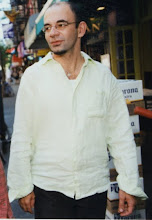Guitarist of the Day: Jonathon Grasse on Surrealestate's Lacunae (Acoustic Levitation)
In the track I Still Dream of Nana, whispering, as a musical-dramatical device, has the effect of drawing the listener into the sound world created by guitarist Jonathon Grasse and the LA-based group Surrealestate on their new release Lacunae on the Acoustic Levitation label.
Grasse is an imaginative and oh-so patient player. He treats the Stratocaster like an alto or soprano instrument, coaxing the most delicate, yet complete, sounds and overtones in what can sometimes be the harshest range of the electric guitar. I’ve always admired this unique aspect of his playing. By the time he shifts into the instrument’s lower ranges, you’ve almost forgotten that the instrument has lows (and this is just part of Grasse’s afore-mentioned patience). In I Still Dream of Nana, he shifts between tonal and non-tempered sounds, and employs articulations that alternately remind me of a koto, gongs and bells, environmental, and imaginary spatial sounds. The recording preserves the nuances of the microstructures that Grasse constructs/releases. Throughout the CD, Grasse draws your attention to his uncluttered yet timbrally loaded guitar gestures. His career as a composer definitely informs his guitar playing. No shredding here, just music through masterful playing…thank goodness.
The title of the album (Lacunae) is perfect for this track, as a metaphor for a (spiritual) space previously unexamined, omitted, or unthought. Grasse’s playing is well suited to the ensemble that includes Charles Sharp on percussion and little instruments, David Martinelli on drum set, Jeff Schwartz on bass. Ken Luey on flute/clarinet/tenor sax, and Bruce Friedman on trumpet.
LA keeps coming up as an expanding place for new and inventive music and as a home to practitioners of the highest quality. Hopefully, Surrealestate's Lacunae, and Grasse’s contribution to it, will get the attention it deserves. This is music beyond category and well worth a listen.
-Amigo





























